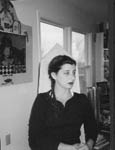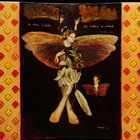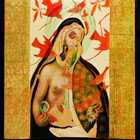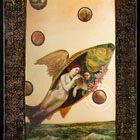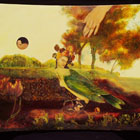WENDY S. ROLFE
artwork | audio | statement | 2008 update
artwork
audio 
(see also Art & Spirituality and Beyond 9-11: The Art of Renewal in Iowa)
- Pursuing art (33 sec. | 231KB): listen | read
- Ideas (28 sec. | 196KB): listen | read
- Shapes (15 sec. | 105KB): listen | read
- Painting process (35 sec. | 240KB): listen | read
- Market & freedom (40 sec. | 275KB): listen | read
- Prayer (15 sec. | 105KB): listen | read
artist statement
As a painter I am trying to go inside everything I create. As a spiritual person I am trying to understand prayer as an effect of the mind and of our thoughts, outside of, but not opposed to the didactic traditions of Christianity. I refer to this as the psychology of enlightenment. I search for concepts and archetypal symbols that best represent this interior path.
I refer to 'Satori', which a Zen term is meaning 'a moment of presence' as well as a rising of inner space between our thoughts. 'Satori space' emanates peace and creative power. It is from within this process that I refer to birds which, in their flight, bring to mind notions of 'desire' and 'freedom'. In this way, 'Feathers' in my paintings represent justice and therefore, right-thinking. The 'monkey' is symbolic in the Hindu faith to mean incessant chattering and lack of discipline of the mind, potentially hindering the process. In its fragility, the 'Lamb' represents the power of innocence and its necessary role in this type of presence.
It is from the scrutiny of these concepts and images, and the exploration of my own personal truths that my studio practice arises.
2008 update
How has your life changed since the interview?
Well, I no longer live on a farm and have moved back to the Dubuque area. I am grateful for this yet I will never regret having lived in one of the most remote agricultural regions of Iowa. The culture was so different that it made a very acute impression on my natural senses.
Living in Dubuque has renewed my sense of community and though I have just recently moved back, I hope to be more intimately involved with the local arts as well as a desire to establish a small grant to support artists and their exhibitions.
What kind of artwork are you doing now?
Somewhat similar to what I have always done, except I am emphasizing my craftsmanship in painting and not so much the metalwork at this time. I feel it is crucial for me to focus on the idea of thought without too many distracting details. Therefore, I am trying to concentrate on simplicity of painting and its philosophy.
What motivates you to continue making Art?
It is what connects me to my inner spirit as well as the desire for sanity in a world where most people feel disconnected, invisible and at times desperate. It allows for inner and universal language to have its voice. The arts to me are what heals and unites all that we do not easily understand and makes us live too long in fear and limitation.
audio text
Pursuing art
I went to the University of Tampa for awhile, and then I got myself out to California. And that's where I started to meet more established artists and be around the arts, and going to the museums and to the exhibits—and when I would go there, I'd go into a trance. Everything else would fold away. I didn't know who was next to me; I didn't know what was going on around me. I would be so drawn to these beautiful works of art, that I knew that I didn't have a choice. That no matter what happened in my life, I'm going to have to pursue this thing. And it's going to take great sacrifice.
Ideas
Sometimes I'll be sitting somewhere and the idea will come and I'll just put it down and then I'll put it away. And then I'll take it back out, and then I'll start to develop it. I do a lot of reading and I look at a lot of art. I will sometimes be excited, and I will do three or four paintings in a row. And then I'm drained. And then at that point I go off and I look at art—I go to New York, I go to Chicago, or L.A., or wherever. And I start to relook at art again, and investigate historical art as well as new art. And then things start to churn again.
Shapes
My work is shape-oriented. I like playing with that. There's no limits to working with wood, tin, and then oil painting with it. I mean, every single time I do it, I don't really repeat myself. They're all different. And they probably will not be repeated, because there's too many new shapes and patterns that I'm interested in.
Painting process
I like being in the process. The beginning is very exciting for me. And the middle is scary, because you're at the point with a painting where either it's going to work or it's not going to work; you have absolutely no idea. And you kind of are lost. To me, if you are in control the whole time, it's probably not going to be an interesting painting. So I always get to the point where I'm excited; boom, I put it out, and then I'm lost forever; and then when I get to the other end, then I kind of...breathe easy and I enjoy it and then I sort of come to the end of it. But, even Picasso said this, every painting's a fight. It's a good battle to the end. And so, I would agree with him there.
Market & freedom
I don't sell as often as some of my friends who are more marketable. That must be fun. But for me it's a different story. It's slower. I have a pretty good season and then for a long time I do not have a good season. But at the same time, though, the freedom of spirit, and just constantly folding yourself into something new and going with it—there's nothing more alive than that. And it has its own existence—its own life.
The more personal my pieces become, the more difficult it is for me to go back. Because I used to do strictly commission pieces and pieces for the market. And I find that very difficult to do. I can't go back that way. So, each piece that, I guess, allows me to be personal is very fulfilling for me.
Prayer
More than anything I like to paint about prayer. Just the idea of being one with God and trying to understand and have perspective on why we're here, where we're going, and how our life can be useful, instead of useless.

